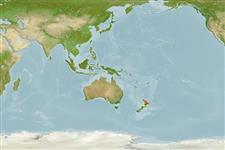>
Acropomatiformes (Oceanic basses) >
Pempheridae (Sweepers)
Etymology: Pempheris: Greek, pempheris = the name of a fish (Ref. 45335); adspersa: Name from Latin 'sparsus' meaning sprinkled or strewn, referring to the small pigment spots observed on preserved specimens..
Environment: milieu / climate zone / depth range / distribution range
Ecologia
marinhas associadas(os) a recifes; intervalo de profundidade 0 - 70 m (Ref. 88976). Temperate
Southwest Pacific: endemic to New Zealand.
Tamanho / Peso / Idade
Maturity: Lm ? range ? - ? cm
Max length : 15.8 cm SL macho/indeterminado; (Ref. 88976)
Espinhos dorsais (total): 5 - 6; Raios dorsais moles (total): 10-12; Espinhos anais 3; Raios anais moles: 29 - 35. This species is distinguished by the following set of characters: some interorbital scales are cycloid; usually 3 or more predorsal scales cycloid, often forming a mesial line of cycloid scales; axillary scale absent; 56-68 lateral-line scales, rarely more than 66; 18-24 scales below lateral line, rarely more than 22; 29-35 anal fin rays; ratio of preanal length to anal-fin base length 1.19-1.55; ratio of pelvic-fin origin to anal-fin origin to anal-fin base length 0.38-0.59; anterior light organ associated with pyloric caeca absent (Ref. 88976).
Nocturnal, retreats to large surge pools or channels open to the sea during the day and usually under overhangs or ledges in small schools. Juveniles occur amongst weed along rocky shores in late summer. Feeds on plankton and benthic organisms (Ref. 26966). Adult diet observed consists of amphipods (45%), mysids (20%), polychaetes (20%), isopods (7%), and crab larvae and ostracods (8%) which are taken out of the water column c. 4-5 m from the bottom. Juveniles that are less than 40 mm are diurnal feeders, mostly feeding on small copepods. Some groups were observed to enter rivers by night in summer and swim well upstream into mangrove forests to feed on crab larvae, shrimps, amphipods, and other zooplankton (Ref. 88976). The smallest identified gravid female was 8.56 cm SL and the largest 12.3 cm SL. Gravid females were found among collections made in mid November into February. These observations agree with reported observations that spawning occurs from November through February and that juveniles settle in January through April (Ref. 88976).
Life cycle and mating behavior
Maturidade | Reprodução | Desova | Ovos | Fecundidade | Larvas
Paulin, C. and C. Roberts, 1992. The rockpool fishes of New Zealand (Te ika aaria o Aotearoa). Museum of New Zealand (Te Papa Tongarewa). 177 p. (Ref. 9003)
Categoria na Lista Vermelha da IUCN (Ref. 130435)
Ameaça para o homem
Harmless
Utilização humana
Mais informação
Nomes comunsSinónimosMetabolismoPredadoresEcotoxicologiaReproduçãoMaturidadeDesovaAgregação para desovaFecundidadeOvosDesenvolvimento dos ovos
ReferênciasAquaculturaPerfil para aquaculturaEstirpesGenéticaElectrophoresesHereditariedadeDoençasProcessamentoNutrientsMass conversion
ColaboradoresFotografiasStamps, Coins Misc.SonsCiguateraVelocidadeTipo de nataçãoÁrea branquialOutras referênciasCérebrosVisão
Ferramentas
Relatórios especiais
Descarregue XML
Fontes da internet
Estimates based on models
Preferred temperature (Ref.
123201): 16 - 18.3, mean 17.6 °C (based on 34 cells).
Phylogenetic diversity index (Ref.
82804): PD
50 = 0.5000 [Uniqueness, from 0.5 = low to 2.0 = high].
Bayesian length-weight: a=0.01122 (0.00613 - 0.02054), b=3.02 (2.85 - 3.19), in cm total length, based on LWR estimates for this species & Genus-body shape (Ref.
93245).
Nível Trófico (Ref.
69278): 3.0 ±0.0 se; based on diet studies.
Generation time: 2.0 ( na - na) years. Estimated as median ln(3)/K based on 1
growth studies.
Resiliência (Ref.
120179): Elevada, tempo mínimo de duplicação da população menor que 15 meses (K=0.55).
Fishing Vulnerability (Ref.
59153): Low vulnerability (10 of 100).
Nutrients (Ref.
124155): Calcium = 27.7 [11.9, 50.7] mg/100g; Iron = 0.241 [0.131, 0.450] mg/100g; Protein = 18.6 [17.4, 19.9] %; Omega3 = 0.32 [0.17, 0.64] g/100g; Selenium = 6.83 [3.00, 16.03] μg/100g; VitaminA = 49.2 [10.5, 227.2] μg/100g; Zinc = 0.702 [0.435, 1.125] mg/100g (wet weight);
